Kimchi stew is one of the most-loved of all the stews in Korean cuisine. It’s a warm, hearty, spicy, savory, delicious dish that pretty much everyone loves. As long as they can handle spicy food, I never met a person who didn’t like kimchi-jjigae.
I learned this recipe from a restaurant famous for kimchi-jjigae in Korea. The restaurant was always full of people eating and sweating over kimchi stew. There was only one item on the menu, so everyone was there for the same thing: a steaming pot of spicy kimchi-jjigae, a few side dishes, and a bowl of warm rice. Customers would call out: “Please give me another bowl of rice!”
What really made an impression on me at the time was the fact that they brought the stew out to the table uncooked, and then fired up a burner and cooked it at the table. This way we could sit and talk and watch it cook. I could get a good look at the ingredients: kimchi, onion, green onion, thinly sliced pork on top, and seasonings. There was some white granules (salt, sugar, and probably MSG) and also they used water at the broth base.
From this I developed my own recipe to make at home, which was very delicious.
My kimchi-jjigae recipe served me well for years and years and I even made a video of it in 2007. But since then I developed this version, which is even more delicious. The secret is in the savory anchovy stock.
I hope you make it and enjoy it for years and years to come!
The difference between kimchi soup and kimchi stew
Kimchi stew is thicker than kimchi soup. Kimchi soup is less salty than kimchi stew.
Also, soup is always served in individual bowls, with rice. Traditionally in Korean cuisine stews were served in a big pot on the table, and the family would eat communally from the pot. These days, some people (including me) get a little freaked out by double-dipping, so for stews I put individual bowls on the table, and a large spoon so that diners can take what they like from the pot and put it in their bowls.
Ingredients
(serves 2 with side dishes, serves 4 without)
- 1 pound kimchi, cut into bite size pieces
- ¼ cup kimchi brine
- ½ pound pork shoulder (or pork belly)
- ½ package of tofu (optional), sliced into ½ inch thick bite size pieces
- 3 green onions
- 1 medium onion, sliced (1 cup)
- 1 teaspoon kosher salt
- 2 teaspoons sugar
- 2 teaspoons gochugaru (Korean hot pepper flakes)
- 1 tablespoon gochujang (hot pepper paste)
- 1 teaspoon toasted sesame oil
- 2 cups of anchovy stock (or chicken or beef broth)
For stock (makes about 2½ cups’ worth):
- 7 large dried anchovies, heads and guts removed
- ⅓ cup Korean radish (or daikon radish), sliced thinly
- 4×5 inch dried kelp
- 3 green onion roots
- 4 cups water
Directions
Make anchovy stock:
- Put the anchovies, daikon, green onion roots, and dried kelp in a sauce pan.

- Add the water and boil for 20 minutes over medium high heat.
- Lower the heat to low for another 5 minutes.
- Strain.

Make kimchi stew:
- Place the kimchi and kimchi brine in a shallow pot. Add pork and onion

- Slice 2 green onions diagonally and add them to the pot.
- Add salt, sugar, hot pepper flakes, and hot pepper paste. Drizzle sesame oil over top and add the anchovy stock


- Cover and cook for 10 minutes over medium high heat.

- Open and mix in the seasonings with a spoon. Lay the tofu over top.


- Cover and cook another 10 to 15 minutes over medium heat.
- Chop 1 green onion and put it on the top of the stew. Remove from the heat and serve right away with rice.

Maangchi's Amazon picks for this recipe
It's always best to buy Korean items at your local Korean grocery store, but I know that's not always possible so I chose these products on Amazon that are good quality. See more about how these items were chosen.






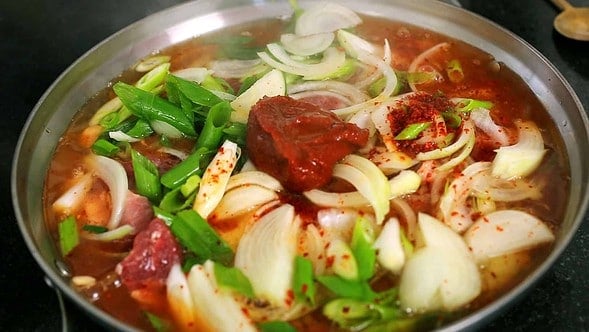



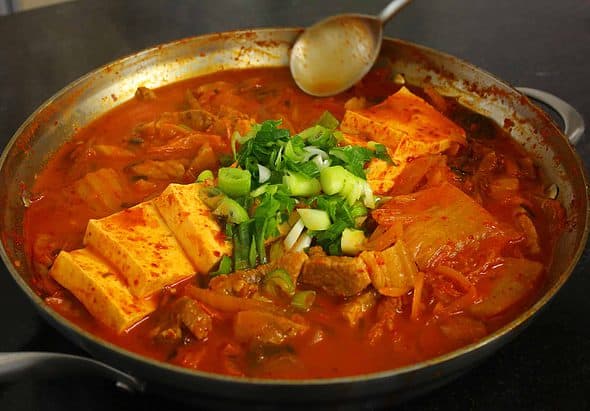











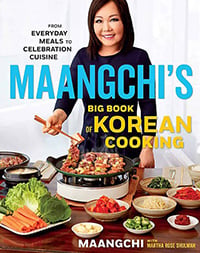































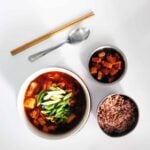


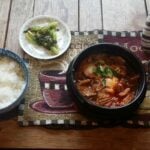

Su,
Happy New Year!
It seems like Korean dramas are popular everywhere! : )
I would like to visit Burma someday.
Hi Maangchi!
This is my very first time to your fantastic site!
I’m from Burma and I started to like Korean dishes by seeing Korean movies! and i really enjoyed to have Korean Traditional Kim chi !
In our country , there are only a few local shops selling Kim Chi.I wonder how nice if i can enjoy the true taste of Korean Kim Chi.
I really like this Kim Chi stew and your recipe is so easy to try this one ourselves!
Thanks for your time and hope i can try your every recipe!
Have a good day!
I love Korea!!
Heather,
Yes, some people add sliced rice cake or noodles to kimchi jjigae(stew).
Hi,
Your video is great! I have eaten a sop that I think is very similar to this in a Korean restaurant, but it had round rice cakes in it. Is that a totally different soup or is it a variation? I really liked the way the rice cakes tasted and would like to try adding them to this recipe if you think that would work.
Mandy from Singapore
yeah, kimchi stew is very easy to make if you have fermented kimchi. I hope your mandu was tasty, too.
Thank you~!
Hi Maangchi,
Me & my friend are so hooked to your recipes. We’ve made kimchi using your recipe. And with the kimchi, i tried this kimchi stew. It is SO GOOD! Very easy to follow recipes!
In fact, i’ve just made some mandu for dinner.
Look forward to see more new recipes.
Cheers!
Mandy from Singapore
Hi Maangchi,
I made kimchi a few days ago using your recipe (but with some Internet research, I decided to add water to the cabbage salting process so that it covers the cabbage completely – it works too) and it is amazing! After 2 days of fermenting, I ate my homemade kimchi with a bean sprout side dish and potato side dish (your recipes). Today, I made kimchi stew! Oh my god!!! I never realised how easy it is to make fabulous Korean dishes at home that I used to enjoy in Korean restaurants overseas. Best thing is, it’s minus the MSG which always gives me a headache.
Just some background info, I’m Chinese-Singaporean currently travelling around the world with my husband and baby girl. We tour with Cirque du Soleil and I have eaten in Korean restaurants in New Zealand, Sydney, Melbourne. The worst ones I have eaten are from a takeaway place in a small town in Germany called Duisburg, and a fastfood style place in Vienna. So I am very very happy that I can learn from you and avoid the crappy ones! Thanks so much!!
BTW, I completely agree that normal chili powder/flakes doesn’t make good kimchi. I’ve not tried this but I’ve eaten kimchi in the abovementioned fastfood style “restaurant” (it’s an Asian restaurant featuring Korean dishes) which I believe used Indian chili powder. Boy!!! Does it taste horrible and powdery….
Anyway, just to say thanks again and hope to see more of your stuff up on the Net.
rona,
oh, I’m very glad to hear that! Thank you for your comment.
Hi maangchi^^
am really thankful that there is someone like you making this blog and cooking video. It`s very easy to follow. I`m a filipina and my husband is korean so this is very helpful for me I often watch your video since I came here in korea 2 months ago and im cooking everything i see on your video^^ it`s fun and very helpful my husband loves it! everytime my husband say it`s delicious i will say maangchi!! with my both hands acting peace.. kinda fun my husband is laughing.
thanhchan,
Strange! I have no problem with watching the bibimbap video.
Hi Maangchi, how are you? Can you please double check on the youtube site because i’ve discovered some problem that it wasn’t working when i tried to watch on how to make bibimbap.
Thank you.
Tetyana,
Oh, really? Leeks and green onions have a similar flavor. Green onions are easy to buy at any grocery store. That’s why I use lots of green onions. Anyway, you can add leeks for the recipe needed green onions, too.
Maangchi,
I have a question, I remember when we lived in Korea, they used alot of leeks in preparing their dishes. I don’t see any recipes with leeks here or I just didn’t find?
Thank you for your answer
Mari,
I like soft tofu, but it depends on your taste.
just want to ask.. what sort of tofu do u recommend for this? firm? soft? not too hard not too soft?
anonymous,
Of course, I sometimes use beef or a can of tuna in kimchi chigae. Oh, chunggukjang (cheonggukjang), sure, I will include it in the list of my upcoming cooking videos. It’s smelly, but delicious. : ) Thank you!
Great recipe Maangchi! Have you ever used beef in kimchi chigae? Just curious whether or not it would work. And do you ever make cheonggukjang chigae? Wondering if you have a recipe for that. Thanks for doing what you do.
Hi maangchi, just to let you know that i made kimchi chigae using my home-made kimchi (following your recipe) with myulchi bokkeum for dinner with friends. they all loved the korean meal and finished everything! :) i forgot to take photos of the dishes; i’ll do it the next time I cook the dishes and post them on my blog. I’ve posted the kimchi and kaktugi that i made on my blog too:) thanks maangchi!
omg thank you maangchi!!! i bought all of the ingredients yesterday ( thank you for the pictures of the peper flakes/paste) and i cooked it today. wow was it heaven!!! it came out perfect thank you sooo much! ^__^ my mom felt proud of me.
Rita,
Thank you for letting me know what it is. Very nice. actually someone else taught me long time ago.
In your video, you had a pickled vegetable that your friend made. The name of that vegetable is called chayote. It looks like a cute inverted green apple or something. :-)
Hi Maangchi! I made some kimchi but I made it so salty so I am going to make kimchi chigae instead. I wish I can come cook and eat with you too in Toronto! I love your cooking shows; I hope to see more and more new recipes. Thank you Maangchi.
brian and anne.h,
Both of you made this dish to fit your taste or situation. As long as it turned out delicious, there will be no problem! Congratuation on your successful kimchi stew!
Dear Maanchi, I just made this with the things I had at home. I subsituted a full onion for the pork belly, because I didn’t have any meat, just tofu. I also didn’t have hot pepper flakes, so I used paprika instead. It turned out pretty well! I will post photos on my flickr account soon. Thanks again for all the great recipes, I will keep trying new ones.
Maangchi,
Just made this dish and it came out yummy! I used a piece of unsliced Hungarian bacon as pork belly wasn’t handy. It gave a nice, very light smokey flavor. Also, I didn’t have any red pepper paste. I live in Baku, Azerbaijan so there are essentially no Korean markets available with the sort of thing. Might you post a recipe for the red pepper paste ? I saw in this page that it was commonly made at home until about mid 1970’s.
I got the idea to use bacon because a new Korean restaurant just opened in town. They served kimchi chigae with sausage and salami and it was quite nice athough I suppose this is Budae Chigae and not proper Kimchi Chigae.
Hi,anonymous,
Hot pepper paste has its own strong flavor, so it’s used for some certain dishes. I never use
hot pepper paste for “Soon du bu jjigae”. But if I see someone else makes soon du bu jjigae using hot pepper paste, I may think it’s interesting. That’s her or his choice, isn’t it?
When I make some seafood stew or vegetable stew, I sometimes use hot pepper paste.
Thanks,
Hello Maangchi,
so I’ve been watching your videos for a while and thank you very much! but I have a question about making korean soup. It seems like sometimes you don’t use hot pepper paste (gochujang) but some other times you use it. and I think you said that we shouldn’t use gochujang in soft tofu stew. is there a general rule on what kind of soup requires gochujang and what kind of soup doesn’t?
thank you!!
Aga,
ok, more banchan(side dishes),
Your beansprouts look delicious!
Maangchi,
I made Kong Na Mool Ban Chan.
I used it for bi bim bab.
http://hk.myblog.yahoo.com/article?mid=143
Cannot wait for more and more Ban Chan from you~
Thanks Maangchi for being so nice to your viewers.
Hi,crazysoulsister,
Happy birthday! Thank you for linking my blog. I checked it out.
You are mentioning “Kimjaang”? Are u a korean? I used to make kimchang(a lot of kimchi for winter) 100 heads of cabbages long time ago, but not anymore. : )
Have a nice day!
Hi Maangchi! I just wanted to direct you to my blog where I just linked to your blog. I made Kimchi today with some friend since it is kimjang season. Soon my friend and I are going to make kimchi by ourselves! Thanks for your vids!
http://crazyseoulsister.blogspot.com/
For deborah,
Hey, thank you for coming! It was absolutely fun. Did you hear your giggling when I said, “good job!” while you were cutting something in the video? I was laughing while editing. Very cute! : )
For anonymous,
I’m anouncing that Deborah has already her own fan now!
By the way, are you requesting Jjajang? I did alreay. check it out please. Thanks,
for james,
Thank you very much for the information. I know what you mean.
I will keep your advice in mind. It’s very useful. I was going to label each word, but it doesn’t seem to work.
As you see, on the left side of my blog, all korean dishes I made is in the list. So I like my blog readers to find out their favorite recipe easily by clicking the name of dish.
Thank you very much!
maangchi, this comment is more about the blog than cooking. the Labels: have to be short words separated by commas. They serve as keywords to categorize similar entries as opposed to titling particular posts. (I hope that made sense.) This makes related blog entries easier to find. For example, a kimchi chigae video would have the labels: kimchi, stew, tofu, soybeans, sprout.
debbie you’re a STAR!! great cooking vid… now i’m hungry! how bout a vid on jajang?
thank you again for inviting me over to your home to teach me how to make kimchi chigae and kong na mool!